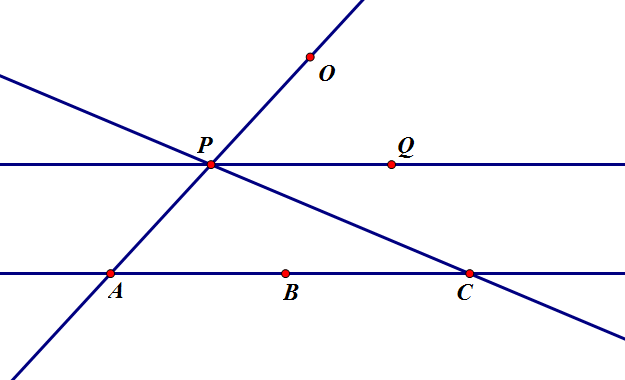개요[편집 | 원본 편집]
동위각이란, 두 직선과 그 두 직선과 만나는 다른 한 직선에 대하여 같은 쪽에 있는 각을 말한다. 위 그림에선 a와 e, b와 f, c와 g, d와 h가 각각 동위각 관계이다. 여기서 중요한 것은, 일반적으로 알려진 사실과 달리, 두 직선이 평행할 필요가 없다. 위상적으로 보았을 때 같은 쪽에 있기만 하면 동위각이기 때문. 따라서 동위각의 크기가 같다는 명제는 두 직선이 평행할 때에만 성립한다. 역으로 동위각의 크기가 같으면 두 직선은 평행하다. 이에 대한 증명은 유클리드의 제 5 공준을 사용한다. 학교에서 증명을 배우지 않는 이유는 이 때문. 증명은 다음과 같다.
증명[편집 | 원본 편집]
두 직선 [math]\displaystyle{ \overleftrightarrow{AB},\overleftrightarrow{PQ} }[/math]가 평행하다고 하자. 증명하고자 하는 바는 [math]\displaystyle{ \angle{OAB}=\angle{OPQ} }[/math]이다. 귀류법을 사용해 증명할 것이므로 [math]\displaystyle{ \angle{OAB}\neq\angle{OPQ} }[/math]를 가정하자. 그럼 [math]\displaystyle{ \angle{OAC}=\angle{OPC} }[/math]를 만족하는 점 [math]\displaystyle{ C }[/math]가 직선 [math]\displaystyle{ \overleftrightarrow{AB} }[/math]위에 존재한다. 왜냐하면 유클리드의 제 5 공준에 의해 점 [math]\displaystyle{ P }[/math]를 지나고 직선 [math]\displaystyle{ \overleftrightarrow{AB} }[/math]에 평행한 직선은 단 하나(직선 [math]\displaystyle{ \overleftrightarrow{PQ} }[/math]) 밖에 없기 때문이다. 이제 그럼 [math]\displaystyle{ \triangle{APC} }[/math]의 세 내각의 합은 [math]\displaystyle{ \angle{PAC}+\angle{APC}+\angle{PCA}=\angle{PAC}+180^{\circ}-\angle{PAC}+\angle{PCA}\gt 180^{\circ} }[/math]이 되어 유클리드의 제 5 공준에 모순이다. 따라서 평행한 두 직선의 동위각의 크기는 같아야 한다.
역으로 두 동위각의 크기가 같은데 두 직선이 평행하지 않다고 가정하자. 즉, [math]\displaystyle{ \angle{OAC}=\angle{OPC} }[/math], [math]\displaystyle{ C }[/math]는 두 직선의 교점이 성립한다. 이제 직선 [math]\displaystyle{ \overleftrightarrow{AB} }[/math]에 평행한 직선을 [math]\displaystyle{ \overleftrightarrow{PQ} }[/math]라 하자. 평행한 두 직선의 동위각의 크기는 같아야 하는데, [math]\displaystyle{ \angle{OPQ}\neq\angle{OPC} }[/math]이다. 이는 모순이므로 두 직선은 평행해야 한다.

